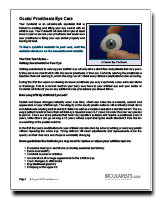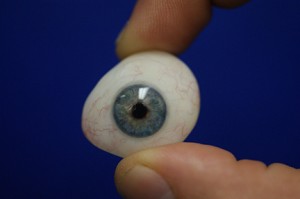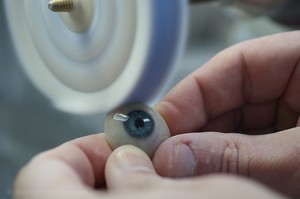Prosthesis eye care: The suggestions and recommendations listed below apply to the average patient. Any instructions that your Ocularist or doctor has given you should always take precedence.
Your Artificial Eye
Your ocular prosthesis is made of heat-cured medical grade plastic (poly-methyl methacrylate) that is designed to create a realistic and comfortable artificial eye. The plastic is lightweight, yet tough enough to resist breakage if dropped.
The First Two Weeks – Getting Accustomed to Your Prosthetic Eye
Getting accustomed to wearing your artificial eye will only take a short time and patients find very quickly they are more comfortable with the ocular prosthesis in than out. Certainly wearing the prosthesis is healthier than not wearing it, and in the long run will inhibit many clinical complications from occurring.
During the first few weeks of wearing an ocular prosthesis you may experience some extra secretions or discharge. This is a normal reaction your body may have to your artificial eye and your doctor or Ocularist will instruct you on any additional care procedures you should follow.
How Long Will My Artificial Eye Last?
Socket and tissue changes naturally occur over time, which can affect the movement, comfort and appearance of your artificial eye. The integrity of the acrylic plastic material will eventually break down and deteriorate causing socket and lid irritation as well as excessive secretions and discomfort. The average patient needs to have their artificial eye replaced every 5-7 years; however this can vary person to person. There are some patients that have very sensitive systems and require a prosthesis every 3 years, while others can go as long a 10 years without experiencing too much discomfort from the micro-leaching of the plastic material.
In the first few years modifications to your artificial eye can often be done by adding or removing plastic without replacing the whole eye. Young children will need adjustments and replacements more frequently as their face size and shape is constantly changing.
Some guidelines that indicate you may need to replace or adjust your artificial eye are:
- Excessive tearing or secretions (excluding seasonal secretions)
- Decreased motility
- Constant dryness or irritation
- An overall small or large appearance to the artificial eye
- Color changes or differences
- Migrated/misaligned iris
- Drooping of the upper lid
Cleaning Your Prosthesis
It is important to keep your eye clean and comfortable and in most cases this can be done without removing the prosthesis by gently wiping or dabbing it with a warm face cloth or washing under the shower. When wiping your artificial eye, be sure to only wipe or rub your eye inward toward your nose, not outward towards your ear. Wiping out toward your ear can cause the prosthesis to eject from your socket due to pressure on the lower lid. Clean your prosthesis in the morning and before you go to bed as described above. Many patients also apply ocular prosthesis lubricate after each cleaning.
Removing Your Prosthesis
Do not remove your prosthesis frequently as too much handling may cause irritation and excessive secretions. Every time your prosthesis is removed and inserted, your body’s immune response is triggered, resulting in prolonged swelling, discharge and discomfort. In rare cases it may be necessary to remove your artificial eye more frequently or before bedtime. If this is the case, your Ocularist will give you alternative care instructions. Usually such cases involve some form of compromised lid anatomy or other condition that requires special maintenance of your prosthesis. Your Ocularist will show you how handle the eye prosthesis. Instructions for removal and reinsertion can also be found on our website HERE.
Polishing/Resurfacing Your Eye Prosthesis
Over time your body’s tears build-up a protein plague on the surface of the prosthesis, making it dull and uncomfortable. If the deposits become heavy, it will irritate the lids and socket anatomy, causing extra secretions, and even pain. This is why it is medically necessary for an Ocularist to polish/resurface your prosthesis regularly. This will restore the shine to your artificial eye and also ensure that the eye socket remains healthy. Just as our own teeth build up a plague that a toothbrush cannot fully remove, the plague on the prosthesis cannot be fully removed by washing. This is why Ocularists are trained on specialized equipment and materials that are designed to properly remove this plague without damaging the prosthesis.
Most patients require a routine ocular prosthesis polishing / resurfacing every 6 months. At this time your Ocularist will also evaluate your socket anatomy and the fit and appearance of your prosthesis, ensuring that it is always looking and feeling as good as possible. Only allow an Ocularist to polish your prosthesis. Opticians and other eye care professionals are not full time Ocularists and often damage prostheses, or at the very least, are not qualified to evaluate socket anatomy, fit, bacterial infiltration, fractures, prosthesis age, PMMA leaching and other factors that contribute to chronic exudate originating from an ocular prosthesis.
Artificial Tears and Eye Lubricants
In most cases your tear glands will still function and flow normally after the removal of your eye. However many patients still experience dryness, irritation or trouble blinking and will need to supplement with artificial tears or lubricants. Head colds, allergies, wind, temperature conditions, being over-tired or touching the prosthesis too much can cause dryness. Ocular prosthesis lubricating drops made specifically for your artificial eye usually only need to be used 1 or 2 times per day. Without removing your artificial eye, simply squeeze a drop directly onto your prosthesis and blink several times to spread the moisture. Consult your Ocularist for a specific lubricating drop for your needs. Some patients find that over-the-counter artificial tears will help maintain moisture and provide relief. These are administered on an as needed basis, usually in the morning, afternoon and evening.
 DOWNLOAD THIS ARTICLE In PDF Format.
DOWNLOAD THIS ARTICLE In PDF Format.


